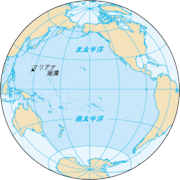Mariana Trench
|
|
The Mariana Trench (or Marianas Trench) is the deepest known submarine trench, and the deepest location in the Earth's crust itself. It is located in the floor of the western North Pacific Ocean, to the east of the Mariana Islands at 11° 21' North latitude and 142° 12' East longitude, which is near Japan. The trench is the boundary where two tectonic plates meet, a subduction zone where the Pacific Plate is being subducted under the Philippine Plate. The bottom of the trench is further below sea level than Mount Everest is above sea level. The trench has a maximum depth of 10,911 m (35,798 feet) below sea level. Taking into account its latitude and the Earth's equatorial bulge, this puts it at 6366.4 km from the centre of the Earth. The Arctic ocean, on the other hand, is ~4 km deep, which would put its floor at ~6352.8 km from the Earth's centre, 13.6 km closer.
It was first surveyed in 1951 by the British navy vessel, Challenger II, which gave its name to the deepest part of the trench, the Challenger Deep. Using echo sounding, the Challenger II measured a depth of 5,960 fathoms (10,900 m) at 11° 19' N, 142° 15' E. This sounding was repeatedly made using earphones to hear the return of the signal as the stylus passed across the graduated depth scale, whilst the timing of the speed of the echo-sounding machine, a necessary part of the process, was made with a hand held stopwatch. For these reasons it was considered prudent to subtract one scale division (of 20 fm) when officially reporting a new greatest depth of 5,940 fm (10,863 m) 1 (http://www.soc.soton.ac.uk/OTHERS/CSMS/OCHAL/deep.htm).
In 1957, the Russian vessel Vityaz reported a depth of 11,034 m (36,201 ft), dubbed the Mariana Hollow; this measurement has never been replicated and is not considered accurate. In 1962 the M.V. Spencer F. Baird recorded a greatest depth of 10,915 m (35,810 ft). In 1984 the Japanese sent the Takuyo, a highly specialized survey vessel out to the Mariana Trench and collected data using a narrow, multi-beam echo sounder; they reported a maximum depth of 10,924 m (35,840 ft) 1 (http://www.soc.soton.ac.uk/OTHERS/CSMS/OCHAL/deep.htm) (this is also reported as 10,920±10 m 2 (http://www1.kaiho.mlit.go.jp/GIJUTSUKOKUSAI/ICO/nl45.html)). The most accurate measurement on record was taken by another Japanese probe, Kaiko, on March 24, 1995: 10,911 m (35,798 ft) 3 (http://web-japan.org/atlas/technology/tec03.html).
Trieste_(23_Jan_1960).jpeg
In an unprecedented dive, the U.S. Navy bathyscaphe Trieste reached the bottom at 1:06 pm on January 23, 1960 with U.S. Navy Lt. Don Walsh and Jacques Piccard. Iron shot was used for ballast, with gasoline for buoyancy. The onboard systems indicated a depth of 37,800 ft (11,521 m), but this was later revised to 35,813 ft (10,916 m). At the bottom Walsh and Piccard were surprised to discover soles or flounder about one foot (30 cm) long, as well as shrimp. According to Piccard, "The bottom appeared light and clear, a waste of firm diatomaceous ooze".
At the bottom of the Mariana Trench, water exerts a pressure of 1086 bar (108.6 MPa or 15,751 psi).bg:Марианска падина cs:Mariánský příkop da:Marianergraven de:Marianengraben nl:Marianentrog id:Palung Mariana it:Fossa delle Marianne pl:Rów_MariaÅski pt:Fossa das Marianas es:Fosa de las Marianas fi:Mariaanien hauta

